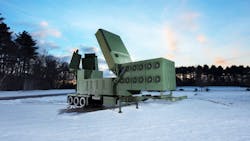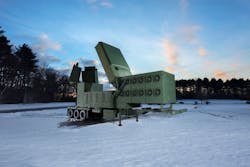As threats become more complex, the U.S. Army realized that its current generation of radar systems would be incapable of detecting higher-speed signals and weapons, necessitating an improved solution. Fortunately, long-time radar systems supplier Raytheon Co. was up to the task of designing a new kind of radar system, optimized for high-speed signals. The company designed its first Lower Tier Air and Missile Defense Sensor (LTAMDS) radar antenna array within 120 days of the initial work order. It provides a highly sensitive means of detecting complex weapons signals, as from hypersonic weapons.
Indoor testing on the first partially populated LTAMDS radar antenna array was completed just five months from the contract award. Bill Patterson, Raytheon’s LTAMDS program director, explained: “The Army set a rigorous and necessary schedule. The timeline...is imperative, because the threat is evolving and proliferating at a blistering pace.” He added: “The Army asked for an advanced radar and we’re showing them that the radar is on track and on time.”
Design and development speed are not properties usually associated with military systems development. But in the case of the LTAMDS radar, the need is for speed—not just in the radar’s performance, but in getting it out into the field because of the growing complexity of advanced weapons threats. The deadline urgency impacts all members of the design team and the role they are playing in the nation’s defense provides the drive they need to push harder during the design cycles.
The next-generation radar uses an actively scanned array antenna. It is designed to provide 360-deg. detection of threat signals and weapons systems. Its development is part of a $384 million contract for six production systems. Raytheon is teamed with many top electronic companies on the project, including Crane Aerospace & Electronics, Mercury Systems and Kord Technologies.
About the Author
Jack Browne
Technical Contributor
Jack Browne, Technical Contributor, has worked in technical publishing for over 30 years. He managed the content and production of three technical journals while at the American Institute of Physics, including Medical Physics and the Journal of Vacuum Science & Technology. He has been a Publisher and Editor for Penton Media, started the firm’s Wireless Symposium & Exhibition trade show in 1993, and currently serves as Technical Contributor for that company's Microwaves & RF magazine. Browne, who holds a BS in Mathematics from City College of New York and BA degrees in English and Philosophy from Fordham University, is a member of the IEEE.

